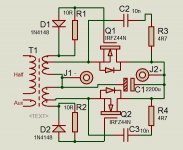What's up guys? This is my first post and I'm sorry for my bad English.. I'm learning yet. My native language is Portuguese and English is so complicated for me. Please if anybody desire to correct something that I wrote wrong or give me tips to improve my words don't be shy, I'll stay too happy 
I developed a single 12V 10A @40khz not regulated SMPS Half Bridge basically with IR2153, 2X IRF840, MUR1620CT and now it works ok I've tested it around a 12,2V X 11,1A for 8 hours long lot of times(more than 10) and everything it's ok, incredibly nothing (more lol) blow up
I've tested it around a 12,2V X 11,1A for 8 hours long lot of times(more than 10) and everything it's ok, incredibly nothing (more lol) blow up  The ambiente temperature is around 28ºC (83ºF). The 2XIRF840's heatsink maximum temperature is 50ºC(122ºF) and I think it's a good temperature. The MUR1620CT's heatsink maximum temperature (measured at 12mm [1/2Inch] of the MUR) is 85ºC (185ºF). Is it too hot? I really don't wanna change the MUR heatsink because there are not more space for it then I will improve a thermal shutdown with auto restart. The MUR1620CT maximum operating junction temperature is 175ºC and finally my question is: How many ºC (or ºF) should I program the shutdown?
The ambiente temperature is around 28ºC (83ºF). The 2XIRF840's heatsink maximum temperature is 50ºC(122ºF) and I think it's a good temperature. The MUR1620CT's heatsink maximum temperature (measured at 12mm [1/2Inch] of the MUR) is 85ºC (185ºF). Is it too hot? I really don't wanna change the MUR heatsink because there are not more space for it then I will improve a thermal shutdown with auto restart. The MUR1620CT maximum operating junction temperature is 175ºC and finally my question is: How many ºC (or ºF) should I program the shutdown?
Thank you all,
Paulo.
I developed a single 12V 10A @40khz not regulated SMPS Half Bridge basically with IR2153, 2X IRF840, MUR1620CT and now it works ok
Thank you all,
Paulo.

